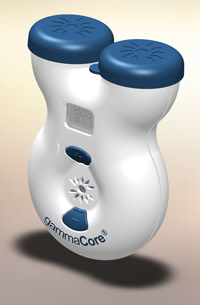Bioelectronics: headache? e-health might be the answer
Simply sign up to the Life & Arts myFT Digest -- delivered directly to your inbox.
It is one of the hottest topics in Silicon Valley: the potential for digital technology to transform the way we manage our health. Apple and Samsung have each announced new e-health platforms in recent weeks that aim to integrate the growing range of apps and wearable devices that track everything from calorie-burn to fertility cycles.
Yet scientists say that gimmicky wristband monitors barely scratch the surface of what will eventually be possible. The big hope, they say, is to move beyond passive monitoring to direct therapeutic intervention. A hint of the future is provided by US company electroCore, which has developed a handheld device that treats migraine headaches with electronic pulses instead of drugs.
Dubbed the GammaCore, the device looks like an electric razor and is placed against the neck, where it stimulates the vagus nerve. The electronic pulses help control a substance called glutamate which has been linked with migraines. In a small clinical trial involving 30 patients and carried out by the University of California, the device provided effective pain relief in 43 per cent of migraine incidents.
GammaCore is an example of a concept dubbed “electroceuticals” or “bioelectronics”. “Our therapy works like a chemical drug but without exposing the body to the toxic side effects that pharmaceuticals often involve,” says JP Errico, electroCore chief executive.

One of the company’s biggest investors is the venture capital arm of Merck & Co, the big US drugmaker. The UK’s GlaxoSmithKline, meanwhile, has set up a $50m venture fund dedicated to bioelectronics with the aim of developing “the first medicine that speaks the electrical language of the body” by the end of this decade.
Errico believes electroCore is on course to beat GSK to that goal. He says the vagal nerve – sometimes called the neural superhighway because of its wide reach – could have a role in treating conditions from depression to respiratory and gastric diseases. Electronic stimulation of the nerve has been used for more than 20 years as a treatment for epilepsy but until now patients have needed an implant fitted. ElectroCore’s breakthrough was to develop a way of delivering the pulses without surgery.
Comments